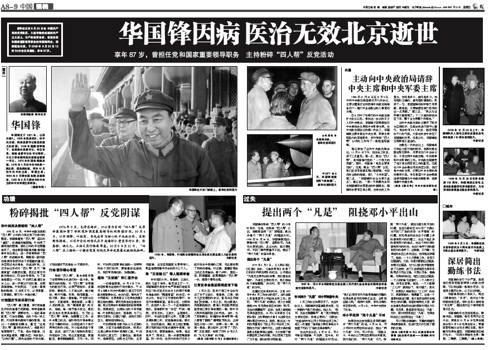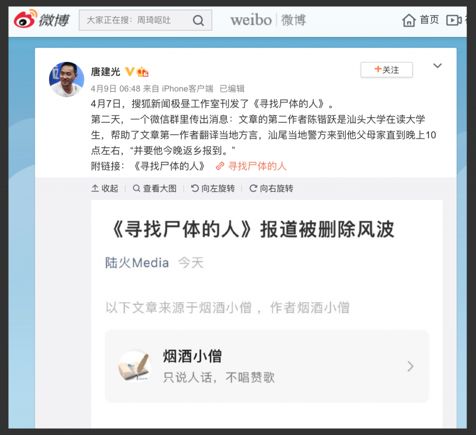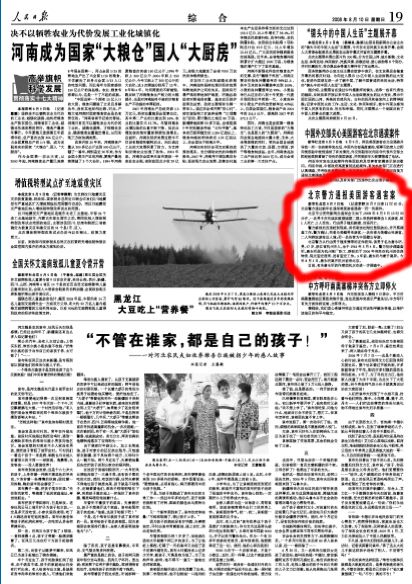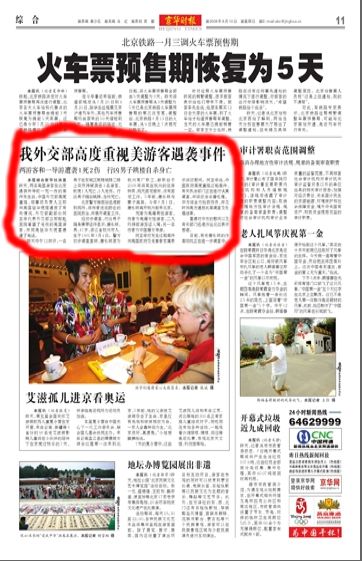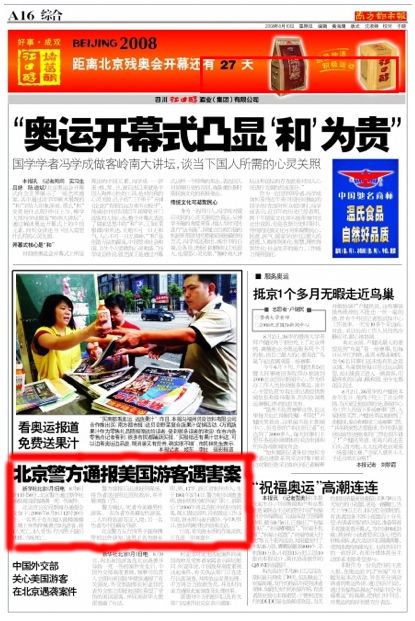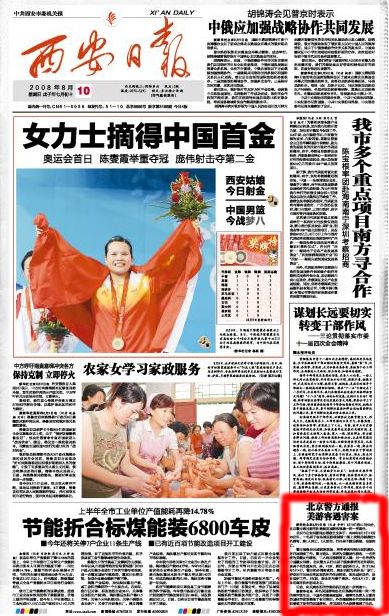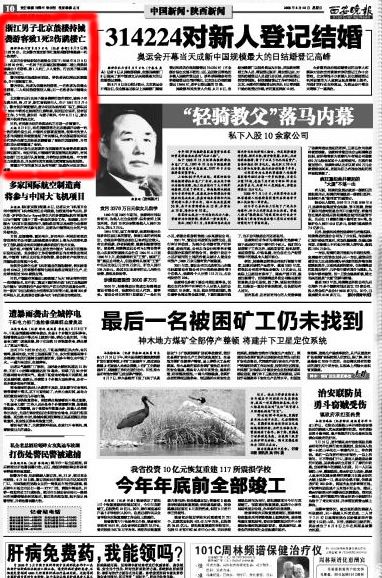Concerning China’s economic miracle, Joshua Ramo, a [former foreign policy] editor at America’s Time magazine, once wrote a report in which he said China had, through great effort, ingenuity and bold experience, managed to find a mode of development that suited its own national realities. He termed this mode the “Beijing Consensus” (北京共识). In his view, China’s experience based on the “Beijing Consensus” has universal value, and can serve as a model for other developing nations, that is to say that it can serve as a model for more backwards countries seeking to spur economic growth and improve people’s lives.
How should we view this synopsis? As institutional economists see it, what neglected factors lie behind China’s economic miracle? Can this high level of economic growth be sustained? On this topic, one of our reporters interviewed Chen Zhiwu (陈志武), a professor of finance at Yale University.
Window on the South: Institutional economists believe that mechanisms for protection of property rights, rule of law, responsible government, etc., are all necessary conditions for economic development. But while China falls short in all of these aspects, it has still managed an “economic miracle.” Has China, then, created a new kind of economic model? How do you assess the “Beijing consensus”?
Chen Zhiwu: Those conclusions from institutional economics are not directed at highly imitative manufacturing economies, because manufacturing does not demand a great deal of institutional environments. For example, when I was a boy in the countryside of Hunan province, we might get scolded by adults for secretly snacking on someone else’s cucumbers. But this was just about taking a bit of cucumber or watermelon, and you would never entertain the thought of taking someone else’s furniture, plundering their belongings, or taking over their house. Clearly, in terms of basic property protection there were strict norms [in my boyhood Hunan], it was only that in that environment the norms governing property rights did not arise from a formal resolution about rule of law, but rather from invisible norms. When life and routine exchanges are confined to those with whom you are familiar, and when the usual products and assets [you come in contact with] are basically tangible things, then the “tangibility” of these tangible things is itself sufficient to guarantee the protection of these assets and their exchange. And so, the crucial thing in this case is not whether there is this solid, non-human system of rule of law.
However, if you want to develop a strong service industry, particularly financial services and other contractually-based economic sectors, and if you want to build a system of intellectual property, then the situation is very different. We are always talking about how profit margins are too low for Chinese manufacturing, that the money is whisked away by Western brands. But turning things around, we must ask why China cannot build its own brands. This is because China’s system of property protection is weak.
A friend of mine who is a lawyer in the United States specializes in patent cases. He has told me that in China if you buy a company’s product (for example, a computer) and afterwards sue the manufacturer, once you get to court, even if you present proof of actual purchase, and even if you present proof that the computer is the brand of the company concerned, Chinese courts will not necessarily agree that your computer indeed was manufactured by the defendant, and the trademark holder will say that the product is a fake in order to avoid taking responsibility. In the end the judges and lawyers will accept this sort of reasoning. If you tell American lawyers about these kinds of decisions, they will find it incredible. Because in the United States if someone buys a computer, even if they do not have a receipt, the trademark holder must take responsibility so long as it is their brand, and they must compensate the consumer. Of course, if it really is a fake, the trademark holder can turn right around and sue the manufacturer of the fake goods, but this is a separate matter altogether. If China’s legal reasoning continues to operate in this way, trademark and intellectual property protection will continue to be a problem, it will be difficult to develop the value of Chinese brands, and Western brands will continue to reap the profits.
As for this “Beijing Consensus,” I think it is too early too say, and it’s a bit hyped. We have to examine China’s economic development for much longer. Each person has his or her own ideals, and when some people rejoice over the victory of the “Beijing Consensus,” I find myself at a loss for words. But it is worth noting that over the last 60 years the international academic community has repeatedly committed the error of drawing conclusions prematurely, and have misled the world. One case in point was the early exaltation of the Soviet model. In the 1930s, the Soviet economy was also growing at a rate of over 10 percent a year. Stagnation in Western economies prompted many people to begin praising public ownership and the planned economy, and leftist economists all believed this was the death knell of capitalism.
From the beginning of the 1940s, Keynes and many other economists promoted the idea of increased government intervention [in economic planning], and the market economies of countries in Western Europe as well as the United States were guided [by national governments]. Many developing nations that achieved independence after the Second World War also looked to the planned economy of the Soviet Union. But by the end of the 1970s and the beginning of the 1980s, this kind of state or controlled economic model had already become impossible to carry on. Renewed privatization became unavoidable. This brought us Reaganomics, the reform of England’s economy under [Prime Minister] Thatcher and a twenty-year tide of global privatization. Many countries have gone full circle because of early, faulty conclusions about the strength of the Soviet economic model and the unfortunate global implications of this.
Another example was the East Asian model. In 1986, not long after I had arrived in the United States as an exchange student, business schools at perhaps every university was looking for scholars who could come and teach who understood the Japanese economy and Japanese culture. They were all researching Asian-style government industry policies and the role of government control in economic development. Japan’s economy began sliding into recession in 1990, and these days business schools don’t teach Japanese management methods or Japanese economic models. In the mid-1990s it was again about the “Asian economic miracle.” Everyone was talking about the strengths of the East Asian model. But when the Asian financial crisis hit in 1997 many people saw their livelihoods destroyed. What will the fate of today’s “Beijing Consensus” be? To each his own view, and history will decide.
Window on the South: What does China’s “economic miracle” mean for people in other parts of the world?
Chen Zhiwu: Chinese manufacturing may have spoiled China’s environment, and the payback for laborers may have been minimal, but it has certainly spurred China’s economic development, and it has at the same time increased the wealth of people in other countries, allowing them to buy more and better products at a lower price. However, for the manufacturing sectors of other countries it is a different picture. Competition from China, coupled with the highly replaceable nature of blue-collar manufacturing jobs and their weak bargaining position, has meant that many workers in many countries have had their opportunities taken. This has to a definite degree exacerbated the conflict between labor and capital in other countries . . .
Window on the South: I think that in order to understand China’s economic miracle, we need to go back to the beginning and look at the course that was chosen. If we don’t understand the early choices we lack the foundation we need to talk about the Consensus.
Chen Zhiwu: Many people attribute China’s economic achievements to the market economy, to its opening to the outside world, to its surplus population, its industriousness and such factors. In fact, these are all true. They are all important. But they are not the foundation [of China’s successes]. In the late Qing Dynasty and the Republican period, China also had a market economy, it had been forcibly opened to the outside world, its proportion of the world population was higher than today, people were just as industrious, but it did not achieve success by the economic standards of today.
What makes China’s economic achievements of the last 30 years stand out? The reason is that China’s economic achievements during this period have been built on a mature [global] foundation of modern industrial technology and a free trade system, and these foundational conditions did not exist in the late Qing or in the Republican period. Today, 85 percent of China’s gross domestic product (GDP) comes from modern industry and service industries, including energy, finance, manufacturing, transport, the Internet, computers, etc. And without exception these all come from the West. China’s products can flow to the whole world because of the free trade system established by the West. So saying China’s economic miracle belongs to China alone is not as accurate at saying it is the product of developments in global modernization.
Naturally, this is just the basis and condition for China’s economic miracle. India, Russia, Vietnam and other countries also have these conditions, but they have not matched China’s miraculous economic growth. This is because China’s national circumstances and conditions differed from these countries during this early round of globalization, and they all took very different development paths.
First of all, since the 1950s China has been through a whole series of poltical movements and human catastrophes, including the Great Leap Forward and the “Cultural Revolution.” Up to the end of the 1970s Chinese society was suffering severe crises on various fronts, and if it did not change it was headed for collapse. This forced people into a process of complete rethinking. When Deng Xiaoping raised his “cat theory” (猫论) those from more left-leaning segments of society perhaps found it difficult to accept, but this became the guiding thought of reform and opening at that time. Moreover, reform and opening gained broad social consensus in China. Even with things as they were, people were propeled by a kind of inertia, and unless they were faced directly with crisis, they were bound to stick to the old path. But by around 1978 the facts already spoke plainly that China’s system was insupportable . . . and in this situation there were few obstacles to carrying out fundamental reforms.
When India achieved independence in 1947 it set up a democratic system with checks and balances on power, elections and a definite degree of rule of law. We know that the goal of democracy is not to seek what are objectively speaking the best possible policy decisions, but rather to prevent others from consolidating power and making poor decisions that harm the society. In this way, democratic systems are about minimizing the degree of bad policy-making, maintaining the status quo, creating harmony and stability and staving off social crisis. Democracy is not suited to grand strokes of reform. Ever since India established democracy the society has been dominated by the [political] left, which opposes marketization, globalization and supports economic planning. Up to 1993, India found it difficult to opt for the reform path of market economics and globalization . . .
[Portion on Russia and China not translated]
Window on the South: Within just a few years of the “Beijing Consensus” being bandied about, Chinese manufacturing has faced numerous difficulties. Do you think China’s high level of economic growth is sustainable?
Chen Zhiwu: It can be sustained. However, this hangs on the question of whether or not China can step ahead in reforming a system the serves the state-run economy, and whether or not constitutional government and rule of law can be developed. Chinese exports have grown rapidly since it joined the World Trade Organization in 2001. In the United States right now, aside from luxury goods consumed by high-income families, nearly all daily household goods consumed by low to middle-income Americans are manufactured in China, from curtains and bedcovers to televisions, computers and furniture. America’s household furniture industry was once centered in South Carolina and North Carolina, but not it has been taken over by Chinese manufacturers. What were once furniture manufacturers have become furniture importers.
At Yale University,where I am now, we have people of all shapes, colors and countries. All of them express great interest in China. This speaks to the influence of Chinese manufacturing, and it also tells us that the likilihood of further Chinese export growth is growing smaller and smaller, that it is no longer realistic to look to expansion of the export market. When we add to this the fact that trade protectionism is now rearing its head [globally], and the fact that manufacturing is on the rise in other developing nations, we can see that China’s current export-led economic model has already run its course, so that it is increasingly unsustainable. The next phase must be led by domestic demand . . .
[Discussion of inadequacies resulting from state control of resource allocation not translated.]
Window on the South: What concerns you most about China’s recent development?
Chen Zhiwu: It is the tendency to “lift the stone and drop it on one’s own foot.” It is human nature “not to weep until you see the coffin.” Even when the situation is serious, if the current system seems sustainable then there is less and less potential for self-examination and innovation. This is particularly true this year, as people [in China] have generally taken a self-defensive posture, and have built themselves up in a frenzy of nationalism, so that they can’t stomach home truths (逆耳忠言). In such a situation, whatever road China wishes to take, those on the sidelines can only look on. When the rain is coming and the bride wants to wed, often times even though you know tragedy awaits, there is nothing you can do. Those who spend all day singing hymns of praise for China accomplish nothing for its progress. Saying pretty things is the easiest thing in the world to do. In fact, those who talk about China’s “coming collapse” are far more valuable for China. We can look constructively at them and try to understand the reasons and forms of collapse they’re talking about, and we can look at what we might do right now to help China avoid this trap.
[Posted by David Bandurski, August 14, 2008, 1:15pm HK]
